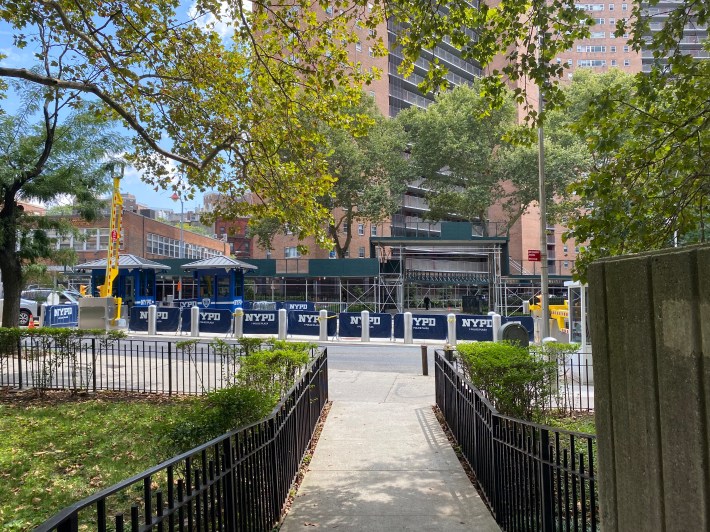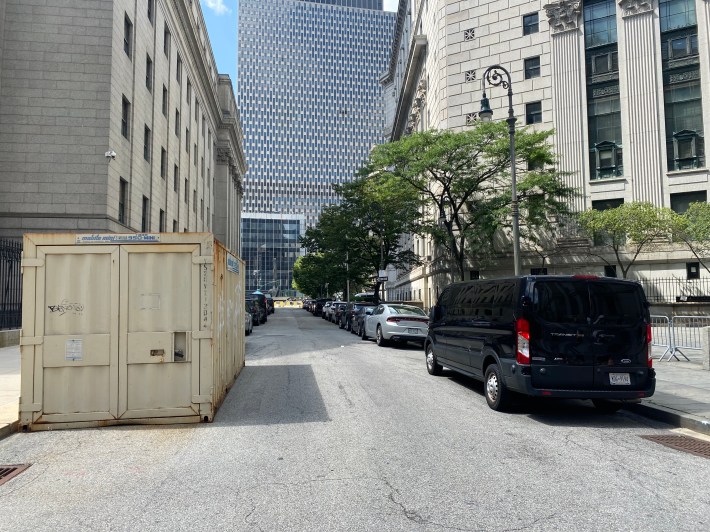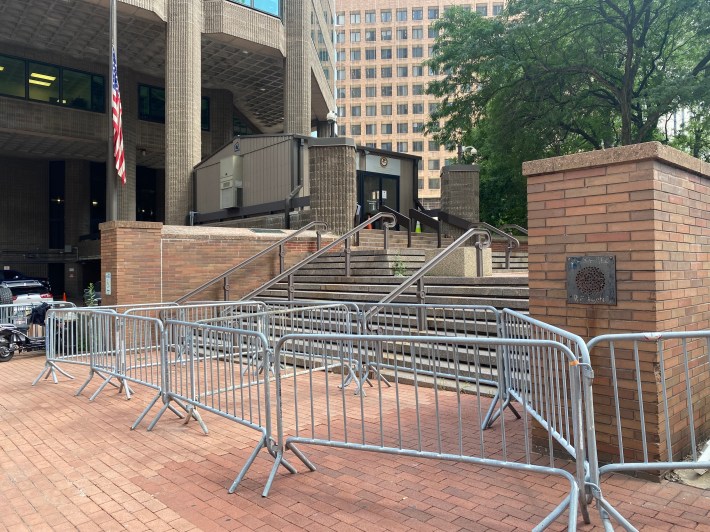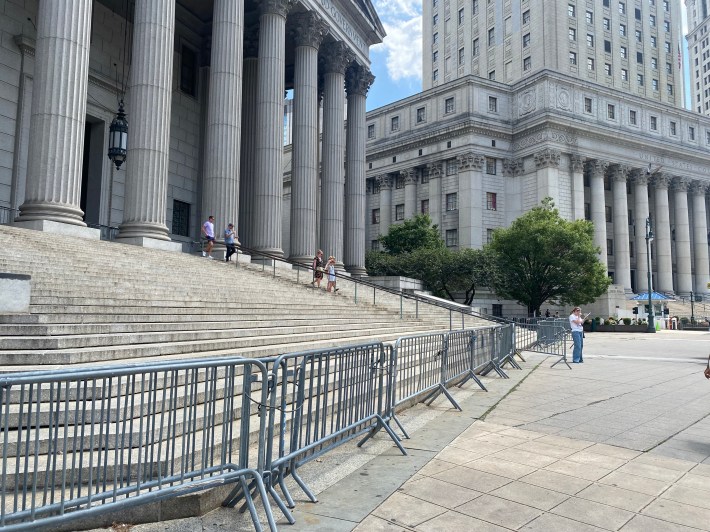The Adams administration's plans to possibly allow private cars back on Park Row for the first time since 9/11 is inspiring locals hoping to reclaim more of the nearby barricaded streets that law enforcement has treated as its fortress for over two decades.
Hostile security measures such as barricades, fences, gates and bollards in the area containing many municipal and federal buildings sever key connectors between Chinatown and the Financial District, hindering the right of locals and visitors to travel freely around the area.
The area's no man's land status outlasted both the wars in Iraq and Afghanistan.
“They’ve made their own fortress, it’s like a moat around a castle,” said Joe Mirabella, a third-generation Chinatown resident, referring to the NYPD. "It’s just a hindrance for us to travel freely in the place that we live."
Since 2001, law enforcement agencies have added more and different types of barriers to the streets around the Civic Center area, which houses NYPD headquarters at 1 Police Plaza, the city's David Dinkins Municipal Building as well as federal and state courthouses.
“Sept. 11 was devastating for the community and we’re still recovering. The question is, do we just want to live in a security zone or do we want to live in a place that’s habitable and welcoming to people?" asked Rosa Chang, president of Gotham Park, a group that has been working with the city to open new parks around the Brooklyn Bridge stanchions.
Metal barricades, cement blocks, and bollards have persisted despite local hopes that the city would figure out a "less ad-hoc" approach by now, Chang added.
Chinatown businesses and Council Member Chris Marte have been lobbying the Adams administration for months to reopen Park Row to private vehicle traffic, with Marte calling in the help from Deputy Mayor for Public Safety Phil Banks, according to a report in the Chinese language press.
Adams said at a recent town hall that he was prepared to relax the Park Row restrictions, but the Department of Transportation is still conducting "outreach" to the public (and, most important, the NYPD).
A 'hostile' zone
The area filled with government buildings and mid-century housing blocks was originally designed to be walkable, according to a local who took Streetsblog on a recent tour of the current border-zone-like infrastructure.
“Welcome to the hostile world of the Civic Center,” said Felix Salmon, a journalist and Chatham Towers resident.

Entering Park Row at Worth Street, bollards line the quiet roadway to prevent drivers from breaking through security by the entry gates.
Cops have also staged NYPD-branded barricades between the pillars — cutting off a natural path for pedestrians to cross between the two main residential developments of the street, Chatham Towers and Chatham Green:

Barricades and jersey barriers continue down Park Row, including an unsettling cage on the sidewalk, which Salmon said officers use for NYPD dogs to rest.

Planners and architects intended for those buildings to be well-connected and walkable for residents of the adjacent neighborhood now littered by metal barricades and fencing, Salmon said.
"It’s haphazard, it's pedestrian hostile, and it’s ugly as sin," he said.
The three streets around 1 Police Plaza — Pearl Street, Madison Street, and another permanently blocked roadway that the city renamed "Avenue of the Finest" — have been barricaded two years longer than the 2001 terror attacks on the World Trade Center further downtown.
NYPD barriers at Rose Street and Frankfort Street, just south of the Brooklyn Bridge, discourage people from going to a just-opened park and skateboard haven dubbed “the Arches,” which Adams cut the ribbon on in May together with Gotham Park.
There were still many people walking around the police ramparts at Rose Street on a recent visit, but the blockades send a clear message to anyone who doesn’t know better that this area is off limits.

That's the look and feel of many of the area's streets.
Chang, of Gotham Park noted that Park Row even has steps directly up to the crowded Brooklyn Bridge walkway and could serve as a gateway for the tens of thousands of people walking the span to enter the downtown neighborhoods, but instead it's dark and uninviting.
"It looks unsafe and unwelcoming, and when you’re not from here you don’t know," said Chang. "We need a street that actually looks like a place that you are welcome and are supposed to be."
Cops have also taken over much of the area's street scape with placard parking, noted Mirabella, who also lives in Chatham Towers.
"Worth Street is a parking lot all day long," he said.
Foley Square across the street has been a constant site littered with illegally parked cars, especially during the high-profile arraignment of former President Donald Trump this past spring, defiling the 50-foot monument "Triumph of the Human Spirit" that honors the nearby African burial ground.

The Boys in Blue should clear the area of their security clutter, or find a new home, the Mirabella said.
“If the police are afraid, let them move somewhere else,” Mirabella said. “I’m very tired of being their human shield. We’re not afraid.”
NYPD declined to comment on any specific security measures; an unnamed rep cited “safety reasons.” City Hall declined to comment on the record.
The nation's largest police department has increasingly closed itself off from public scrutiny, citing its "security" needs.
The cops have begun encrypting their radio communications, silencing crucial channels for the press to cover incidents, and its patrol guide omits sections about dangerous vehicle pursuits, which have spiked during the Adams administration.
Court contempt
It’s not just the city’s "Finest" clogging the neighborhood's streets and sidewalks: Federal and state officials have their own barriers and checkpoints on Pearl Street, which runs between the courthouses and to Foley Square. The public street has come to look more like the judiciary’s private drive, Salmon said.
“People are allowed on both sides, but we’re gonna make it really forbidding for you,” he explained.

And here's what court officials have done with the space:

An overgrown ramp leads up from Park Row to the back of the U.S. Attorney’s Office across from 1 Police Plaza, but metal fencing at the top prevents access to the ramp, and the adjacent space that could provide an easy access to the Municipal Building and beyond has instead become a parking lot:

The abandoned walkway connects to the federal prosecutor's offices at the Silvio J. Mollo Federal Building, a brown Brutalist building with green windows, which is set to undergo a three-year, nearly $300-million makeover starting in May.
The entrance steps of the stilted building's front at 1 St. Andrews Plaza behind the Municipal Building is littered with steel barricades, leaving just a slim section open for people.

Metal fencing has also gone up in recent years in the walkway off Pearl leading to Worth Street and in front of the Daniel Patrick Moynihan U.S. Courthouse, at 500 Pearl St., and these barriers arrived after the George Floyd protests against police brutality in the area three years ago, locals said.
At the Worth Street entrance, officials doubled up the barriers, completely blocking the ledges and much of the walkway to Pearl Street where there's already metal bollards to prevent a breach by someone using a car:

Barricades line almost the entirety of the stairs up to the state and federal courthouses on Centre Street, including the iconic colonnaded entrance of the State Supreme Court featured on “Law and Order.”
“The one thing you see over and over again is a weird allergic reaction to people walking up stairs,” said Salmon.

A spokesman for the state’s Office of Court Administration blamed skaters causing damage to the steps and handrails of its 1920s courthouse.
“The broad set of steps going from the sidewalk to the colonnade at the entrance have been fenced off for a number of years to prevent skateboarders from the continued damaging of both the granite steps and brass handrails. There are no plans to remove them in the immediate future,” Lucian Chalfen said in an email.
The U.S. General Services Administration, which manages the federal buildings, did not respond to multiple requests for comment, but in a recent presentation to Community Board 1, an official showed the power of the NYPD to dictate security, even over federal officials.
"Those barricades were not installed by us right now, those barricades were installed by the NYPD,” Scott Elgart told CB1’s Quality of Life & Service Delivery Committee on April 19, referring to the set of barriers in front of the Silvio Mollo building's steps. “You walk right past [the Silvio] Mollo [building] to get to 1 Police Plaza.”
The GSA plans to stage construction equipment and cranes on the north side of Park Row in what is currently a lane of parking, but the federal officials didn't mention the defunct walkway in their presentation and exclusively referred to the area as parking.

From 'Gruzen Country' to 'Barrierville'
The gated setups go against the design ethos of the neighborhood's buildings, Salmon said — many of which (including, ironically, 1 Police Plaza) were by architects Gruzen and Partners, earning the area the nickname "Gruzen Country."
The Civic Center's apartment blocks and government buildings were built over what was once part of the notorious Five Points neighborhood that was redeveloped in the 1960s and '70s to make way for a new neighborhood of government buildings and modern apartment blocks. Other Gruzen designs nearby were the Chatham Towers and Chatham Green, the Metropolitan Correctional Center, and Murray Bergtraum High School.
Critics praised the new police headquarters when it opened in 1973, saying its public plaza and street connections gave “a kind of coherence by extension to the entire fragmented area of City Hall and Foley Square" — despite the cops having “balked at the site plan at first, unhappy about allowing its front yard to be a neighborhood shortcut.”
The NYPD's inclination to barricade itself from the public remains, and the plaza reverted to an obstacle course of fences and barriers in the decades sense.

In the years after 9/11, NYPD's Counter Terrorism Bureau decided that a “secure zone” around 1 Police Plaza should remain to “prevent the possibility of a vehicle bomb attack on NYPD Headquarters,” according to the agency's 16-year-old “Security Plan."
Gotham Park, together with skating legend Tony Hawk, plans to open more spaces between Park Row and Pearl Street as the city wraps up a restoration of the Brooklyn Bridge next year, said Chang.
She was optimistic because the police have been working with her group, and, she said, have been “enormously fair to ideas to improve our public spaces.”
"We can use Park Row as the catalyst to reconsider, frankly, all of our securitized spaces," Chang said. "It could be proof of concept."
Salmon hoped that the city could return "Gruzen Country" to its original ideals as part of the Park Row plans.
"A Park Row redesign is not going to solve all the problems of the federal district," he said, "but they should be part of the conversation.”






